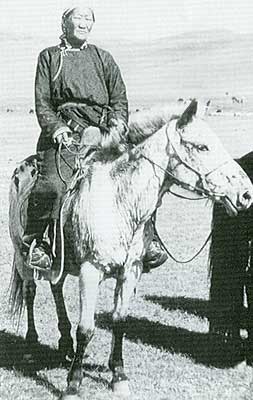
|
 |
 |

The Horses of Genghis Khan
Mongol Rider

In his American Appaloosa Anthology, Palmer J. Wagner describes the eastern Hunnic peoples of the vast central Asian steppe. Referred to as Hsiung-Nu by their Oriental neighbors, little is known about their horses. Yet, one breed was recorded to have an erect mane.
About that time, during the Han dynasty in China, a most magnificent horse was acquired from The Valley of Ferghana to the west. This class of swift horse was better suited to warfare than the typical China workhorse and could defend Emperor Wu Di against his long-time enemies, the Hsiung-Nu. The Great Wall, in Wu Di's time had frequent gaps and it would take the speed and toughness of these superior horses to repel raiders from the north. Wu Di sent many caravans to trade silks for these highly-prized Ferghana horses. Chinese art later immortalized the war horses, referring to them as Celestial Horses.
These remarkable animals, also referred to as the Heavenly Horses and Blood-Sweating Horses by scholars and art historians, were known for their speed, agility, and stamina. Many bore an unmistakable spotted-coat pattern.
In the hundreds of years to follow, border raids by the Hsiung-Nu resulted in an immeasurable number of these Ferghana horses being captured and infused into local herds. Thus, the spotted coat of the great warhorse found the erect mane of the nomadic workhorse -- the foundation of the early Appaloosa.
The Mongols were direct descendants of these Hsiung-Nu. Numbering about 700,000, most were herdsman living fragmented in small bands north of the Gobi Desert. Each band was headed by a chief or Khan. Adept at moving great distances, the Mongols hunted in winter and traded livestock and timber from Siberian forests in summer.
Spare grazing conditions made their little horses tougher than those of their Chinese neighbors to the south. They frequently fought over grazing land and, occasionally, raided for goods. The Mongol warriors of the early 1200's were highly disciplined, superbly coordinated, and fearless. As horseman, they were without equal. As Palmer quotes Sidonius' description,"Scarce had the infant learnt to stand without his mother's aid when a horse takes him upon his back. You would think that the limbs of man and horse were born together, so firmly does the rider always stick to his horse..." Palmer describes that the Mongols walking gait "seemed odd". A similar, bandy-legged gait was also reported by survivors of Comanche raids, when the riders dismounted to scalp and loot. Unlike agricultural people, Mongol and Comanche alike grew up and spent their entire lives horseback.
As for the Mongol's horses, they were small, incredibly tough and sure-footed. They were able to survive on sparse grazing and were sometimes fed by their riders while on the march. They carried their riders and provisions and mares were often milked for nourishment. Blood, if needed could also be drawn from a leg on long campaigns and the flesh of the horse consumed, if necessary.
Early in his life, a Mongol named Temujin rose to power over local families and joined Ong Khan in a successful fight against the Tartars. Declared an adopted son, Ong Khan named the young man his successor. By age 42, Temujin's battles and conquests had been so successful that he took the title of Oceanic or Universal Ruler, which translates to Genghis Kahn.
All Genghis Khan's military enterprises were mounted campaigns, often at great distances under the harshest conditions and against numerically superior enemies. In spite of their hard use, Mongol horses were better cared for than the horses of their enemies. According to James Chambers, Genghis Khan forbade the leading of a horse by the bit, a practice common in many horse shows today!
After his success in China, Genghis Kahn was forced to launch a war against Khwarizm, a newly-formed Islamic empire to the west. In the coldest of winter months, the Mongols rode across the desert to Transoxiana with no personal gear and very little in provisions so to appear from a distance as merchants. The strategy was a stunning success and Genghis Kahn pushed deeper into the Islamic empire - into Afganistan and Persia and on toward Baghdad, which soon surrendered. While he consolidated his new conquests, Genghis Khan sent 40,000 horsemen through Azerbaijan and Armenia. The men defeated Georgian Crusaders and spent the winter near the Black Sea. As they were headed home, they met 80,000 warriors led by Prince Mstitslav of Kiev. The battle of Kalka River began. The Mongols stayed out of weapon range and drew the mounted aristocrats after them in a fake retreat. Their horses lighter and more mobile, the Mongols quickly tired the mounts of their pursuers, strung them out and defeated them.
By 1225 Genghis Khan ruled everything between the Caspian Sea and northern China. He declared freedom of religion throughout his empire and brought his people undreamed-of trade commerce and prosperity, even creating an efficient pony express system. His horses grew to be highly-prized throughout Asia and were traded to cultures all over the continent, accounting for Appaloosas found in India and Korea today. Descendants of Genghis Khan's horses remain in great number in Mongolia. Several of my friends who have traveled there to hunt sheep have described the spotted horses used by local herdsman.
In terms of square miles, Genghis Khan was the greatest conqueror of all time - greater than Alexander the Great. His success was the result of unparalleled leadership and mobility. There was simply no mounted force able to hold its own against him. His were the world's best riders on the world's best horses.
Appaloosas in Mongolia today



|
| Back | Top | Next |
|
 |

